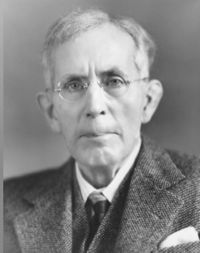Conger, Arthur Latham
(1872-1951). Conger was born in Akron, Ohio, on January 30, 1872. At 18 he entered Harvard and while there discovered theosophy. He joined the Theosophical Society (TS) on June 16, 1892, and was admitted into the Esoteric Section by William Q. JUDGE in 1894. After he graduated from Harvard, his parents insisted he enter the Episcopal Theological Seminary at Cambridge as a candidate for Holy Orders, when he was 22, but his theosophical views were not tolerated, and he chose to leave rather than give up theosophy. He went to work at the international headquarters of the Theosophical Society in New York City then under the direction of Katherine TINGLEY, becoming her first private secretary. In 1897 he was elected an officer of the newly formed International Brotherhood League, a theosophical organization to work with prisoners, the less fortunate, and children. In January 1898, the Universal Brotherhood was formed as an umbrella organization for the Theosophical Society and the International Brotherhood League. Conger was one of the original signatories of the new constitution along with Basil Crump, A. E. Neresheimer, Robert Crosbie, and Joseph H. Fussell, to name a few.
After the outbreak of the Spanish-American War, Conger joined the military. He rose through the ranks rapidly, and during WWI General Pershing appointed him Chief of the Department of Intelligence. In 1916 he co-founded and edited a quarterly named The Military Historian and Economist and that same year wrote two historical documents, The Function of Military History, and President Lincoln as War Statesman. In 1921 he wrote The Military Education of Grant as General, and he authored The Rise of U.S. Grant in 1931. Among his many decorations he received the Silver Star Citation for gallantry (1900), the Distinguished Service Medal (1919), the Legion of Honor from the Government of France (1919), and the highest award given by the French government, the Croix de Guerre (1919).
In 1920 Conger graduated from the Army War College, Washington, D.C., and was made Lieutenant Colonel. He was promoted to Colonel on April 27, 1921, and commanded the 20th Infantry Regiment for two years. He served his last four years as Military Attache to both Berlin, Germany, and Berne, Switzerland, then retired from active service October 31, 1928. The Harvard 50th Anniversary Report of the Class of 1894 described A. L. Conger in the following manner:
- Our foremost army officer, with a training based on a study of the Classics and of oriental religions and practice in musical composition; military historian; adept in the acts of friendship and foreign diplomacy; well deserving servant of our country.
Conger’s return to formal theosophical work occurred in 1922 during Katherine Tingley’s stay at Fort Sam Houston, Texas. Shortly thereafter, he and his wife, Margaret Guild Conger, were guests for a few months at the international headquarters in California of the Point Loma (now Pasadena) Theosophical Society. While Military Attache in Berlin, Colonel Conger was of great assistance to Katherine Tingley during her European lecture tours, and continued close contact with her until her death in 1929.
Conger extended to her successor, Gottfried de PURUCKER, the same quality of service he had given Katherine Tingley. In 1932 Conger became President of the American Section, but his struggle with Parkinson’s disease caused him to resign in 1933. When his health improved, he was again elected President in 1939. Aside from introducing new organizational methods, he encouraged fresh, creative presentations of theosophy. He also ran a regular study group on The Mahatma Letters, at which H. N. Stokes, editor of the O. E. Library Critic, was one of the regular attendants. Stokes appointed Conger his literary executor.
Conger became Leader of the Theosophical Society in 1945, three years after Purucker had moved the international headquarters to Covina, California. During the post-WWII era of change, Conger guided the Society toward a broader recognition of humanity’s need for a theosophic perspective on global issues and daily living. The Society expanded under his leadership, lectures resumed both nationally and internationally, new printing equipment was installed, and an enlarged publishing program kept the classics in print and added new books to the literature.
In September 1950 he inaugurated the move of the international headquarters from Covina to Pasadena, California. Foreseeing new needs for the Society he sent James A. Long on a world tour of the national sections to meet with officials and members. His first stop was England, where he received a directive from Colonel Conger: to close the Esoteric Sections in each country. Shortly after James Long’s return, Conger died at his home at the headquarters in Pasadena on February 22, 1951.
A.E.D.
[All references in this article to the Theosophical Society after 1895 are to the Theosophical Society (Pasadena)]
